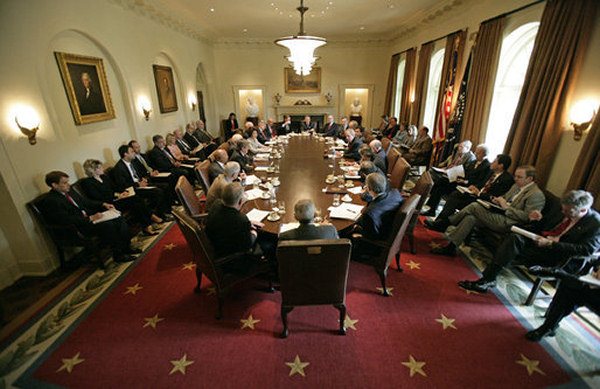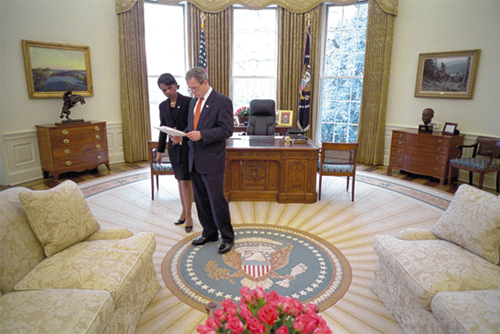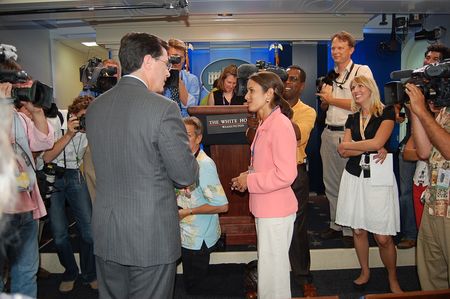Our instructions were to show up at the Northwest Appointment Gate at 8:55 AM on Friday morning. My parents had flown up from Georgia; Mrs. Feiler Faster and I had made our way down from New York. My Dad had booked us two rooms at the Hay-Adams hotel, across Lafayette Park from 1600 Pennsylvania Avenue, “where nothing is overlooked but the White House.” My wife had asked what she should wear. “Not pants,” I said, remembering Bush’s admonition that all guests to the Oval Office should be dressed appropriately. “At my age, you wear what’s comfortable,” my Mom responded, who wore a pantsuit. One of the first things I noticed after we passed through security was a sign that said:
Those not appropriately dressed and wearing the following will not be allowed to tour the West Wing: jeans, sneakers, shorts, mini skirts, t-shirts, tank tops, flip flops
We were met by an extremely charming White House aide. She led us up the drive, past “Pebble Beach,” where the networks have their permanent cameras for stand-up, through the front door of the West Wing, which was manned by a Marine, and into what she described as a “holding room.” The holding room, in this instance, turned out to be the Cabinet Room.
The familiar table filled most of the room, and you could look through the windows and see the Rose Garden, which was surprisingly bereft of roses. The Charles Wilson Peale portrait of George Washington hung on one wall, with a hand-tucked-into-his-coat pose later made famous by Napoleon, and opposite was a marble bust of Washington looking like Caesar. There was a painting of the signing of the Declaration of Independence, a portrait of Eisenhower, and, oddly I thought, the bust of a non-president: Benjamin Franklin.

The chairs were by far the most telling part. Each leather chair had a brass plate on the back depicting the title of the person who sat there, like “The President,” with the date he first occupied it. Josh Bolton’s chair had two plaques, one for his job as head of Office of Management and Budget, another for Chief of Staff. The most plaques belonged to Cheney’s chair: “Vice President,” “Secretary of Defense,” and “Chief of Staff,” with the dates he held each of those jobs. Given the problems plaguing the Attorney General, someone joked it might be time to be making a new chair.
There were several other groups waiting to make their way into meet the president, and we were instructed to expect a brief period of time. At 9:30 AM, Senator Saxby Chambliss, R-Georgia, arrived to accompany to us. About ten minutes to ten, we were moved to the dark lobby just outside the Cabinet Room, and a few minutes later, through the open door, into the Oval Office.
My first impression was how light the room was, and how heavy the air. Part of this is an architectural trick. I renovated an apartment a few years ago and my architect talked about the power of making small, ante-rooms darker, so that the large room you enter has even more impact. That’s exactly what happens when you enter the Oval Office. Given the warren of enclosed, window-less rooms you have to make your way through before you get to the Oval Office, the act of entering a room with so many windows, with an illuminated, white ceiling, and bright, almost stage lighting inside, is very dramatic. Mike Deaver was the first to relight the room, I had read, and the effect on your irises, if nothing else, is intense. Putin, upon entering, apparently uttered, “Oh, my God.”
The other source of intensity, of course, is the person entering the room. You bring a lot of the emotion with you – the nervous anxiety, the twisting of hands, the sense of history. And I wasn’t coming to make a major decision, or negotiate a bill, or apply for a Supreme Court judgship. I could only imagine the emotion of some of those visitors.
One of the ways I experienced the entire morning was as a boy who had grown up talking about politics around the breakfast table, studied American history, and been reading that week about the burning of the White House in 1812 and Abraham Lincoln giving speeches from the second floor. For that part of me, entering the Oval House was a thrill, and I had made the appropriate fuss. I had gotten my suit pressed, my shoes shined, and when I found out that morning that my collar was lacking a stay, I took a Q-tip, circumcised it with a nail clipper, and inserted it into my collar. That’s right: I wore a Q-tip to the Oval Office.
President Bush was standing on the light-colored rug that the First Lady designed, in front the desk used by FDR and JFK. He was wearing a blue suit, a red tie, and cowboy boots. He was very shouldery, I thought, and more formal than I expected. He welcomed us to the Oval Office. I had been led to expect joking, maybe even towel-snapping. Instead, the first substantive words out of his mouth were about Iraq. We were entering the Oval Office at an important time in our history, he said, we had to have a sense of history, our actions would be judged by history. Hands were shaken, books were handed over, the president repeated some nice words about my book ABRAHAM, which had triggered the invitation. And then, considering that he had led with seriousness, I decided to ask about his faith.

I mentioned that I am writing a book about the Bible in America, and had been studying the influence of religion from the Pilgrims to the present, and wondered about his relationship to the text. What followed was a 20-minute conversation about his personal faith, about the relationship between church and state in America, and about religion and the Oval Office.
At several points in the conversation, the president asked that specific remarks he made be kept private. I shall abide by his request. Within those bounds, I feel comfortable observing that the tenor of the conversation was about the separation of church and state in America, how a president could have personal faith but ought not impose his faith on others, how Islamic extremists press their beliefs on others and we do not. He said he was not vain enough to feel called by God but felt he should serve God.
Later, the topic turned to my wife, who runs a not-for-profit called Endeavor, which supports entrepreneurs in the developing world, and which the president’s commerce secretary recently praised at the White House. The president encouraged her to expand her efforts to the Palestinian territories, where he said Tony Blair would be focusing efforts on building up the economic and governmental infrastructure. With that opening, I turned the topic back to the topic of Abraham, which had brought us together, and mentioned that the interfaith movement was a century old but had not had a galvanizing moment. I wondered if he thought an “Abraham Summit” might help. He expressed interest in the idea, but suggested the world didn’t want another speech by him or conference with little follow-up. Grassroots efforts would be more effective, he said.
“Now I have to boot you out,” he said, and we commenced the taking of pictures. As we left, he gave us some gifts for our twin daughters. When he learned our girls had just turned two, he said, “You’re in the beginning innings of a long game, and the middle innings are tough.”
As I mentioned, I experienced the entire morning on several different levels. As an American, to be invited to the Oval Office by the president, and to be able to go with my parents and wife, was a singular privilege. As a political junkie, I was fascinated at every turn, from the planning that went into our visit to the back and forth between the president and the senator when they met, was happening on a level that I couldn’t entirely untangle. Politics on this plane a multi-level game. Finally, on a human level, I would say that I did not find the president, the office, or the staff isolated, as one often hears. From his opening comments about the war to the general tone of the conversation, I would say that the president is clearly cognizant of the debate going on in the country right now.
Last fall, I was invited to give a speech at the First Lady’s National Book Festival on the Mall. The seventy or so writers included every year are invited to the East Room for a buffet breakfast. The overwhelming impression I had during that visit is that the house really does belong to everyone. We could even sit on the sofas and eat our croissants. The Bushes, like everyone before them, are just temporary residents.
I had a similar feeling during my visit to the West Wing. Every room I walked into, including the Oval Office, had a depiction of George Washington. The past is omnipresent here, as is the future. Nearly every sentence out of the president’s mouth had something to do with how someone before him had conducted himself in his position, or how someone later would judge his actions. I found him steeped in the weight of time. The walls in the Oval may not speak, but they surely listen.
And that’s what I took away from my visit. The Oval Office is not otherworldly. It’s a room, where the light is a little bit lighter, the air is a little bit heavier, and where no person, not even the president, is ever alone.

